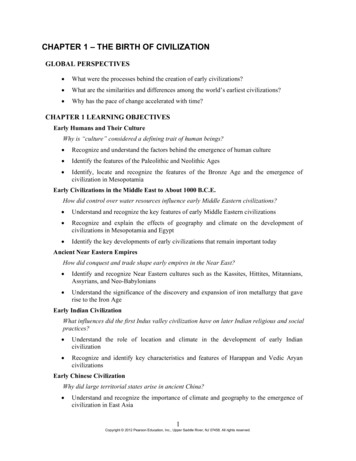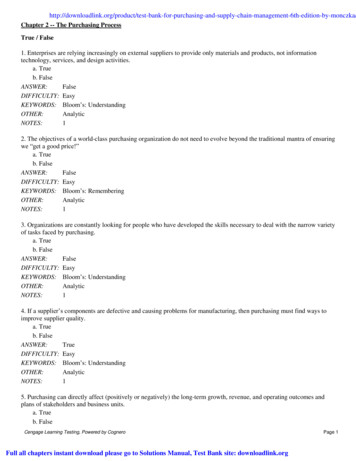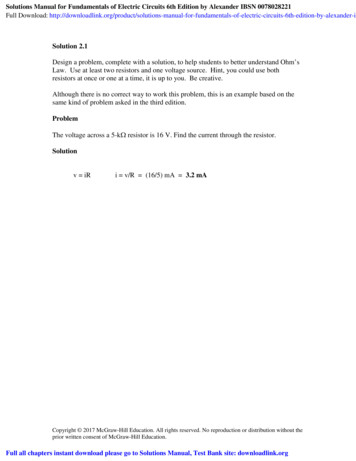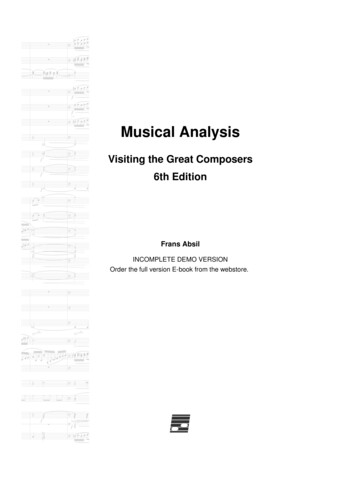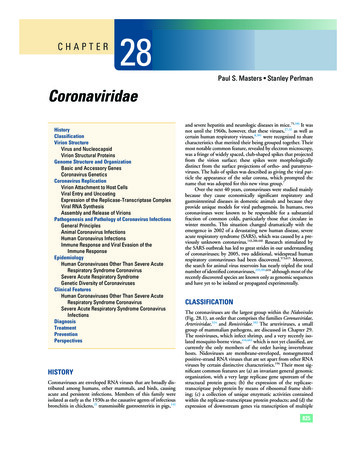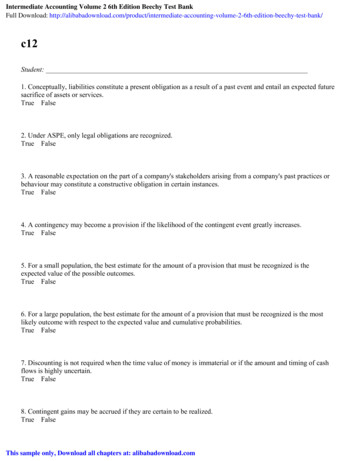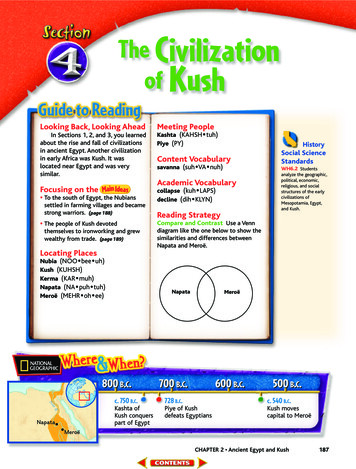
Transcription
The Civilizationof KushLooking Back, Looking AheadMeeting PeopleIn Sections 1, 2, and 3, you learnedabout the rise and fall of civilizationsin ancient Egypt. Another civilizationin early Africa was Kush. It waslocated near Egypt and was verysimilar.Kashta (KAHSH tuh)Piye (PY)Content Vocabularysavanna (suh VA nuh)Academic VocabularyFocusing on the To the south of Egypt, the Nubianssettled in farming villages and becamestrong warriors. (page 188) The people of Kush devotedthemselves to ironworking and grewwealthy from trade. (page 189)collapse (kuh LAPS)decline (dih KLYN)HistorySocial ScienceStandardsWH6.2 Studentsanalyze the geographic,political, economic,religious, and socialstructures of the earlycivilizations ofMesopotamia, Egypt,and Kush.Reading StrategyCompare and Contrast Use a Venndiagram like the one below to show thesimilarities and differences betweenNapata and Meroë.Locating PlacesNubia (NOO bee uh)Kush (KUHSH)Kerma (KAR muh)Napata (NA puh tuh)Meroë (MEHR oh ee)Napata800 B.C.NRile.NapataMeroë700 B.C.600 B.C.500 B.C.c. 750 B.C.728 B.C.c. 540 B.C.Kashta ofKush conquerspart of EgyptPiye of Kushdefeats EgyptiansKush movescapital to MeroëMero eCHAPTER 2 Ancient Egypt and Kush187
WH6.2.8 Identify the location of the Kush civilization and describe its political, commercial, and cultural relations with Egypt.WH6.2.9 Trace the evolution of language and its written forms.NubiaTo the south of Egypt, the Nubians settled in farming villages and became strong warriors.Reading Connection Are you on good terms with yourneighbors? It’s not always easy—for individuals or countries. Read on to find out about the Egyptians’ neighborsto the south and the ways the two civilizations mixed.The Egyptians were not alone in settlingalong the Nile River. Farther south, inpresent-day Sudan, another strong civilization arose. This was in a region calledNubia (NOO bee uh), later known as Kush(KUHSH).Historians do not know exactly whenpeople arrived in Nubia. Evidence suggeststhat cattle herders arrived in about 2000 B.C.They grazed their herds on the savannas(suh VA nuhs), or grassy plains, that stretchacross Africa south of the Sahara. Later, people settled in farming villages in Nubia. Theygrew crops, but they were also excellenthunters, skilled at using the bow and arrow.Soon the Nubians began forming armiesknown for their fighting skills.The Kingdom of KermaThe more powerful Nubian villages gradually took overthe weaker ones and created the kingdomof Kerma (KAR muh). Kerma developedclose ties with Egypt to the north. TheEgyptians were happy to trade for Kerma’scattle, gold, ivory, and enslaved people.They also admired Nubian skills in warfareand hired Nubian warriors to fight in theirarmies.Kerma became a wealthy kingdom. Itsartisans made fine pottery, jewelry, and metalgoods. Like Egyptian pharaohs, the kings ofKerma were buried in tombs that held precious stones, gold, jewelry, and pottery. Theseitems were as splendid as those found inEgypt during the same period.In this wall painting, four Nubian princes offer rings and gold to an Egyptian ruler.What kingdom was formed when more powerful Nubian villages took over weaker ones?188CHAPTER 2 Ancient Egypt and Kush
WH6.2.6 Describe the role of Egyptian trade in the eastern Mediterranean and Nile valley.WH6.2.8 Identify the location of the Kush civilization and describe its political, commercial, and cultural relations with Egypt.Why Did Egypt Invade Nubia?As youlearned earlier, the Egyptian pharaohThutmose III sent his armies into Nubia inthe 1400s B.C. After a 50-year war, the kingdom of Kerma collapsed, and the Egyptianstook control of much of Nubia. They ruledthe Nubians for the next 700 years.During this time, the people of Nubiaadopted many Egyptian ways. They beganto worship Egyptian gods and goddessesalong with their own. They learned howto work copper and bronze and changedEgyptian hieroglyphs to fit their own language. As people and goods continued topass between Nubia and Egypt, the twocultures mixed.Identify Where was Kushlocated in relation to Egypt?Kush Kingdom c. 250 B.C.The Rise of KushThe people of Kush devoted themselves to ironworking and grew wealthy from trade.Reading Connection Do you and your friends evertrade video games or CDs? Trading may be a casualactivity for you, but it was essential to ancient peoples.Read to find how Kush took advantage of its locationalong an important trade route.As Egypt declined at the end of theNew Kingdom, Nubians saw their chanceto break away. By 850 B.C., a Nubian grouphad formed the independent kingdom ofKush. For the next few centuries, powerfulKushite kings ruled from the city of Napata(NA puh tuh).Napata was in a favorable location. Itstood along the upper Nile where tradecaravans crossed the river. Caravans sooncarried gold, ivory, valuable woods, andother goods from Kush to Egypt.Mediterranean Sea30 E30 NARABIAR.EGYPT50 EN ileMemphis40 EReThebesdKEYa20 N0NapataNWKushSeSAHARAMero e300 mi.0300 kmLambert AzimuthalEqual-Area projectionES10 N1. Location Which of Kush’s capital cities wasclosest to Egypt?2. Human/Environment Interaction Based on itslocation, where might trade that passed throughKush have come from?These Kushite pyramidswere much smaller andhad more steeply slopedsides than Egyptianpyramids. How else wasMeroë rebuilt to looklike an Egyptian city?CHAPTER 2 Ancient Egypt and Kush189
to bury their kings. The ruins of these pyramids can still be seen today.Selecting aNew KingWhen their king died, the Kushites askedthe god Amon-Re to appoint a new leader.“[The Kushite officials said] ‘We have come toyou, O Amon-Re . . . that you might give to usa lord. . . . That beneficent office [helpful task]is in your hands—mayyou give it to your sonwhom you love!’Then they offered theking’s brothers beforethis god, but he did nottake one of them. For asecond time there wasoffered the king’sbrother . . . Aspalta . . .[Amon-Re said] ‘He isyour king.’”Lion statuein honor ofKing Aspalta—author unknown,c. 600 B.C.,“The Selection of Aspaltaas King of Kush”Do you think Aspalta was qualified to beking? Why or why not?In time, Kush became rich enough andstrong enough to take control of Egypt.About 750 B.C., a Kushite king namedKashta (KAHSH tuh) headed north with apowerful army. His soldiers began theconquest of Egypt that his son Piye (PY)completed in 728 B.C. Piye founded theTwenty-fifth Dynasty that ruled both Egyptand Kush from Napata.The kings of Kush greatly admiredEgyptian culture. In Napata they builtwhite sandstone temples and monumentssimilar to those of the Egyptians. TheKushites also built small pyramids in which190CHAPTER 2 Ancient Egypt and KushThe Importance of Iron Kush’s rule inEgypt did not last long. During the 600s B.C.,the Assyrians invaded Egypt. Armed withiron weapons, they drove the Kushites backto their homeland in the south.Despite their losses, the Kushites gainedsomething from the Assyrians—the secretof making iron. The Kushites became thefirst Africans to devote themselves to ironworking. Soon, farmers in Kush were usingiron for their hoes and plows instead ofcopper or stone. With these superior tools,they were able to grow large amounts ofgrain and other crops.Kush’s warriors also began using ironspears and swords, increasing their militarypower. Meanwhile, traders from Kushtransported iron products and enslavedpeople as far away as Arabia, India, andChina. In return, they brought back cotton,textiles, and other goods.A New CapitalAbout 540 B.C., Kush’s rulersleft Napata and moved farther south to beout of the Assyrians’ reach. In the city ofMeroë (MEHR oh ee), they set up a royalcourt. Like Napata, the new capital hadaccess to the Nile River for trade and transportation. The rocky desert east of Meroë,however, contained rich deposits of ironore. As a result, Meroë became not only atrading city but also a center for makingiron.With their growing wealth, Kush’skings rebuilt Meroë to look like anEgyptian city. Small pyramids stood in theroyal graveyard. A huge temple sat at theend of a grand avenue lined with sculptures of rams. Sandstone palaces and redbrick houses had walls decorated withpaintings or blue and yellow tiles.
Building a Profitable TradeMeroë becamethe core, or center of a huge trading networkthat stretched north to Egypt’s border andsouth into central Africa. Kush’s tradersreceived leopard skins and valuable woodsfrom the interior of Africa. They tradedthese goods, along with enslaved workersand iron products, to people throughout theMediterranean and the Indian Ocean area.Kush remained a great trading powerfor some 600 years. By the A.D. 200s, though,the kingdom began to weaken. As Kushdeclined, another kingdom rose to take itsplace. The kingdom is called Axum andwas located in what is today the country ofEthiopia. Around A.D. 350, the armies ofAxum burned Meroë to the ground. Youwill read more about the kingdom of Axumwhen you study Africa.Kushite KingThe Kushite king Taharqawas one of the mostpowerful leaders inNubian history. Duringhis reign, the kingdomgrew and prospered.He built many largetemples in andaround Egyptand Kush. Whatkingdom replacedKush?Kushite kingTaharqaExplain How did Kushbecome a wealthy kingdom?Study Central Need help with the kingdomof Kush? Visit ca.hss.glencoe.com and click onStudy Central.Reading SummaryReview the In the Nile Valley to the south ofEgypt, the Nubians founded thekingdom of Kerma and tradedwith the Egyptians. The Kushites set up a capital atWhat Did You Learn?1. Who were the Nubians?2. What were the Kushites’ mostimportant economic activities?Critical Thinking3. Sequencing Draw a diagramto show events that led up tothe Kushite conquest of Egypt.CA 6RC2.44. Geography Skills Whywas Napata’s locationbeneficial? CA CS3.5.6. Compare How were Kush andEgypt similar? CA 6RC2.27.Meroë that became a center forironmaking and the base of ahuge trading network.Kush Conquestof EgyptHow did Egypt’sculture affect Kush? CA 6RC2.0PosingQuestions If you wanted tolearn more about Kush, whatquestions would you ask?Write three questions andexchange them with a classmate. Research each other’squestions and write a summaryof your findings. CA HR1.CHAPTER 2 Ancient Egypt and Kush191
WH6.2.7 Understand the significanceof Queen Hatshepsut and Ramses theGreat. WH6.2.8 Identify the locationof the Kush civilization and describe itspolitical, commercial, and culturalrelations with Egypt.The Mighty PharaohsIn Egypt and Kush, rulers were greatly respected. The Egyptians believedthat their pharaohs were the sons of the sun god, Re. Because of these beliefs,the pharaoh had enormous power. His word had to be followed without question.Read the passages and study the image that follows. Then answer thequestions on page 193.Tutankhamen’sgold maskReader’s DictionaryRe (RAY): god of sunbegat (bih GAT): fatheredstele (STEE lee): a vertical, engravedstone slabspake: spokeremnant (REHM nuhnt): remainderOsiris (oh SY ruhs): a god, king of theAfterworldAmon (A muhn): god of Thebes; important Egyptian godRamses II RebuildsR amses II, one of the great pharaohs ofEgypt, ruled from 1279–1213 B.C. Ramses IIundertook a large-scale building project. Thefollowing passage comes from an inscriptiondescribing his order to finish building hisfather’s tomb.“I came forth from Re, although ye say,from [Seti I], who brought me up. . . . Whenmy father appeared to the public, . . . [h]esaid concerning me: ‘Crown him as king,that I may see his beauty while I live withhim.’ . . . My mighty deeds for my father asa child, I will now complete, being Lord ofthe Two Lands; I will construct them in the192CHAPTER 2 Ancient Egypt and Kushproper way . . . I will lay the walls in thetemple of him that begat me. . . . I willcover its house, I will erect its columns, Iwill set stones in the places of the lowerfoundation, making monument upon monuments.” . . .Then spake the royal companions, andthey answered the Good God: “Thou artRe, thy body is his body. There has been noruler like thee, (for) thou art unique, likethe son of Osiris, thou hast achieved thelike of his designs.”—Anonymous, “Ramses II Finds theNecropolis Buildings in Ruins”
A Kushite Warrior-KingA Sphinx of KushAround 728 B.C., the Kushite king Piye finishedThe people of Kush adopted many Egyptianhis conquest of Egypt. He was angry to discoverthat some of the enemy had not been destroyed.The following description appears on Piye’s victory stele.Then his majesty was enraged thereat likea panther (saying): “Have they allowed aremnant of the army of the Northland toremain? . . . Not causing their death, in order todestroy the last of them? I swear: as Re lovesme! As my father Amon favors me! I willmyself go northward, that I may destroy thatwhich he has done, that I may make him turnback from fighting, forever.”ways, especially while they ruled Egypt. Thisgranite sphinx is of the daughter of King Piyefrom about 660 B.C. Egyptians believed thatsphinx statues had magical powers to guardtombs and temples.This sphinx has the face of King Piye’sdaughter. It guards a sacred offering vessel.The vessel was filled with gifts to the godAmon. These offerings were protected by thesphinx, which held the vessel in its hands sono one could steal it.—Anonymous, “The Nubian Invasion”Ramses II RebuildsA Sphinx of Kush1. Who does Ramses say is his father?2. Why does Ramses want to finish Seti’s tomb?3. Ramses’s royal companions say that he is Re,the sun god. Why do you think they say this?6. The Egyptians were known for creatingsphinxes, yet this sphinx was made for adaughter of a king of Kush. Why do you thinkthis is so?7. Compare this sphinx to the images of theGreat Sphinx on pages 152 and 166. How arethey alike? How are they different?A Kushite Warrior-King4. Why is Piye so angry?5. According to Piye, what is his relationshipwith the Egyptian gods Re and Amon? Why isthis relationship important?Read to Write8. Reread the two passages, as well as theinformation about the sphinx. What do theseprimary sources tell you about the role ofreligion in the lives of Egyptian rulers? Howdo they demonstrate the power of pharaohs?CA HR3.CHAPTER 2 Ancient Egypt and Kush193
Standard WH6.2Review Content VocabularyMatch the definitions in the second column tothe terms in the first column. Write the letter ofeach definition.1. savannaa. area of fertile soil atthe end of a river2. tributeb. reed plant used tomake baskets, rafts,and paper3. cataractc. grassy plain4. deltad. rapids5. hieroglyphicse. Egyptian writingsystem6. pharaohf. forced payments7. papyrusg. title for EgyptianleadersReview theSection 1 The Nile Valley8. What natural barriers protected Egyptfrom invasion?9. What two areas of Egypt were unitedaround 3100 B.C.?Critical Thinking16. Describe Identify the four social groupsin ancient Egypt, and explain whobelonged to each group. CA 6RC2.417. Synthesize How do you think religiousleaders reacted to Akhenaton’s changes?CA HI2.18. Analyze Do you agree that Egyptian civilization can be called “the Gift of theNile”? Explain. CA HR2.19. Compare In what ways did Meroë looklike an Egyptian city? CA 6RC2.2Geography SkillsStudy the map below and answer the followingquestions.20. Location The Nile River delta emptiesinto what body of water? CA CS3.21. Movement Why would ancient Egyptiansfind it easier to travel north and south thanto travel east and west? CA CS3.22. Human/Environment Interaction Why isEgyptian farming along the Nile? CA CS3.Ancient EgyptSection 2 Egypt’s Old Kingdom10. What were the Egyptians’ religious beliefs?11. Where did Egyptians of the Old Kingdombury their pharaohs?Section 3 The Egyptian EmpireNile ValleyNILE DELTALOWER EGYPT30 NGizaGreat Pyramidand TERNDESERTaThebesNEWSCHAPTER 2 Ancient Egypt and KushSeUPPER EGYPT14. Where did the Nubians live?15. What made the Kushites wealthy?dSection 4 The Civilization of Kush194KEY30 EN il12. During what period did Egypt reach theheight of its power?13. Why are Akhenaton and Tutankhamenwell-known?Me d i t e r r a n e a n Se aFirst Cataract
Read to Write23.Expository Writing Imaginethat you are an Egyptian pharaoh. Howwould you make sure that your empire isstable and strong? Use real-life pharaohsto help you determine what kinds ofthings you would do. Write an essaydescribing your policies and what youhope to achieve through them. CA 6WS1.224. Using YourUse your foldable towrite a description of one of the civilizationsin this chapter. Include such things as religious life, family life, and contributions.When you are finished, discuss similaritiesand differences among the civilizations witha classmate. CA 6WS1.3Self-Check Quiz To help prepare for theChapter Test, visit ca.hss.glencoe.com31.Building a Time Line Take alook back through the chapter. As you go,make a list of each important leader inancient Egypt. Create a time line of theseleaders, placing them in chronologicalorder. For each entry, include a short summary of their reign. Describe their significant accomplishments or mistakes, andhow these actions affected Egypt.CA CS2.Using Academic VocabularyUse the terms below to fill in the blanks in thefollowing sentences.a. featuree. structureb. technologyf. principlec. laborg. restored. welfareh. construct25. An important of Egyptian pyramidsis the shape.26. The shadoof is an example of Egyptian.27. A pyramid is a large made of stoneblocks.28. Pharaohs were in charge of providing forthe of their people.29. Egyptian pharaohs used farmers to helptheir pyramids.Use the map below to answerthe following question.Early CivilizationsKJLNWReviewing Skills30.Summarizing Using information from the text, create a short storyabout Hatshepsut. Use this writing exercise to summarize life in ancient Egyptduring her reign. The story should compare Hatshepsut to other Egyptian rulersand explain the differences in her policies.The events of the story should also showthe different social classes in Egypt andexplain the problems Hatshepsut faced asa woman pharaoh. CA 6WA2.1ESM32 Which area on the map was thehome of the Kushite kingdom?ABCDJKLMCHAPTER 2 Ancient Egypt and Kush195
76–77 Anthony Pidgeon/Lonely Planet ImagesTheAncientIsraelitesThe wall surrounding theold city of Jerusalem2000 B.C.1300 B.C.c. 1800 B.C.Abraham leadshis people toCanaan600 B.C.A.D. 100c. 1290 B.C.722 B.C.A.D. 66Moses leadsIsraelitesfrom EgyptAssyriansconquerIsraelJews revoltagainstRomans
Chapter Overview Visitca.hss.glencoe.com for apreview of Chapter 3.The First IsraelitesReligion shapes how culture develops, just as culture shapes how religiondevelops. The 12 tribes of Israel in the land of Canaan weredescendants of Abraham. The Israelites believed in one God whogave commandments telling people how to live good lives.The Kingdom of IsraelAll civilizations depend upon leadership for survival. Under David andSolomon, the people of Israel built a powerful kingdom with anew capital in Jerusalem.The Growth of JudaismReligion shapes how culture develops, just as culture shapes howreligion develops. The Jews continued to keep their religion eventhough other people ruled them. They settled in many places inAsia and Europe.View the Chapter 3 video in the Glencoe Video Program.Summarizing Information Make this foldable and use it to organize note cardswith information about the Israelites.Step 1 Fold a horizontalsheet of paper (11”x17”)into thirds.Step 2 Fold the bottom edge up two inches andcrease well. Glue the outer edges of the tab tocreate three pockets.Gluehere.Gluehere.Step 3 Label the pocketsas shown. Use thesepockets to hold notes takenon index cards or quartersheets of paper.Reading and WritingAs you read the chapter,summarize key facts onnote cards or on quartersheets of paper aboutIsrael and the growthand spread of Judaism.Organize your notesby placing them inyour pocket foldableinside the appropriatepockets.FirstJudaismIsraelites Israel’s SpreadsKingdom197
WH6.2.8 Identify the location of the Kush civilization and describe its political, commercial, and cultural relations with Egypt. WH6.2.9 Trace the evolution of language and its written forms. 188 CHAPTER 2 Ancient Egypt and Kush In this wall painting, four Nubian princes offer rings and gold to an Egyptian ruler. What kin

